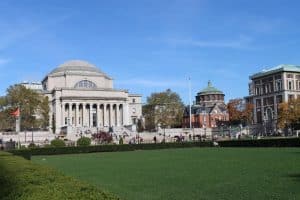Where is Columbia Located?
Columbia University is a renowned institution with a rich history and a prestigious reputation. Read on to learn more about Columbia, including where this institution is located and its distinguishing attributes within higher education.
Where is Columbia located?
Columbia University is in New York City, at 116th Street and Broadway in Manhattan’s Morningside Heights. This location places it within one of the most dynamic cities globally, offering unique academic and professional growth opportunities.
Academic and Urban Life
Morningside Heights is home to several educational institutions, creating a vibrant academic community. Columbia’s presence here blends tradition with innovation, reflected in the campus architecture and student opportunities.
The Importance of Location
Being in New York City allows Columbia students to access museums, theaters, and internships, enriching their academic journey. The city’s resources complement the university’s offerings, facilitating a well-rounded education.
Campus Design
Columbia’s campus, featuring the Low Memorial Library steps, is designed to foster learning and community. It reflects the university’s commitment to providing an environment conducive to academic success and personal growth.
Global Engagement
Columbia encourages students to engage with communities locally and globally, preparing them for leadership in an interconnected world. The campus community and international programs enhance students’ educational experiences, readying them for global challenges.
Is Columbia private or public?
Columbia University, a distinguished member of the Ivy League, is one of the oldest and most prestigious private institutions in the United States. Its private status allows for significant flexibility in funding, leading to investments in research, faculty, and financial aid programs.
The Significance of Being Private
Columbia operates on tuition, donations, and endowments rather than state funding. This financial independence supports its commitment to academic excellence and innovation. It enables Columbia to offer programs and maintain a vibrant research environment.
Academic Excellence and Innovation
Columbia challenges and inspires students through a rigorous Core Curriculum, ensuring a well-rounded education. The curriculum sharpens your critical thinking skills in a variety of subjects. The university also embraces technology and interdisciplinary study, preparing students for future challenges.
Research That Makes a Difference
Columbia applies its research efforts to address global challenges, working on projects from climate change to medical advancements. This approach demonstrates the university’s role in societal progress.
A Brief History of Columbia
The history of Columbia University showcases its growth from a small college into a leading global university. Founded in 1754 as King’s College by a charter from King George II of England, Columbia University, located in New York, is the state’s oldest institution of higher education and ranks fifth oldest in the United States. The university has contributed significantly to society through research, scholarship, and leadership.
Origins and Revolutionary Times
Columbia began before the American Revolution to educate youth in liberal arts and sciences. The war disrupted its operations, but it reopened as Columbia College in 1784, aligning with the needs of an independent nation.
Growth in the 19th Century
The 19th century saw Columbia expanding its curriculum and moving to accommodate more students. It became Columbia University in 1896, signaling its status as a comprehensive research university.
20th Century Innovations
The 20th century underscored Columbia’s role in innovation, contributing to FM radio development, the Manhattan Project, and more. It has produced numerous Nobel and Pulitzer Prize winners.
Columbia Today
Now, Columbia is known for its research and scholarship in various fields. Its global centers extend its influence worldwide, and it actively engages in solving global challenges. Columbia’s history reflects its evolution and commitment to advancing knowledge and societal betterment. Its alumni and faculty have led significant advancements in many fields, proving the university’s role in shaping the future.
How big is the Columbia campus?
Columbia University, located in New York City, is known for its academic excellence and beautiful campus. This university’s design showcases Columbia’s commitment to a supportive learning environment.
Design Influence
McKim, Mead, and White significantly impacted American architecture in the late 19th and early 20th centuries. Their functional and aesthetic vision for Columbia’s campus creates a cohesive look. Each building adds to this narrative, demonstrating academic and historical depth.
Space Use in an Urban Environment
Columbia’s 36-acre campus efficiently supports various academic disciplines, research initiatives, and student activities. This approach reflects Columbia’s innovative education and community engagement strategy in an urban setting.
Historical Significance
Columbia’s move to Morningside Heights in 1897 allowed it to grow into a leading global university. Its buildings have been part of important historical events and research breakthroughs.
Community and Student Life
The campus design promotes interaction, building a strong community. Spaces like Low Memorial Library steps and College Walk serve as student gathering spots and venues for public events.
Sustainability Efforts
Columbia’s sustainability initiatives reflect its commitment to a greener future, balancing historical preservation with environmental responsibility.
Innovation and Research
The campus design facilitates cross-disciplinary collaboration, leading to innovative projects. Columbia’s investments in modern facilities and its New York City location offer unique partnership opportunities.
What are the available facilities inside Columbia?
Located in the heart of New York City, Columbia University provides a comprehensive, enriching environment for its students, faculty, and staff, with many facilities to enhance academic and extracurricular experiences. Let’s explore these facilities in detail.
1. Safety Measures
Columbia University prioritizes your safety and security. The university employs security personnel at strategic campus locations and residence halls.
Moreover, you’ll find a secure environment with over 3,000 cameras monitoring campus activities. For emergencies, Columbia offers a 24-hour emergency text messaging system and an evening shuttle service, ensuring safe travel across campus during nighttime.
2. Green Initiatives
Columbia is dedicated to sustainability. It’s increasing its LEED-certified buildings and has expanded recycling programs to include light bulbs and batteries. Additionally, converting laundry rooms to energy-efficient machines shows Columbia’s commitment to water conservation and energy savings.
3. Academic and Research Facilities
The university boasts advanced academic and research spaces. The Interdisciplinary Science Building features offices, classrooms, and labs for various scientific disciplines. A science library in the Northwest Corner Building supports interdisciplinary research, providing a rich resource center for students and faculty.
4. Athletic and Recreation Facilities
Columbia offers the Baker Field Athletic Complex for athletics and recreation, equipped with amenities for student-athletes. The Boathouse Marsh restoration project provides a natural community and environmental education area, emphasizing recreational spaces and environmental preservation.
5. Housing Services
Columbia offers a variety of housing options for both undergraduate and graduate students. With over 3,900 undergraduate rooms and housing for more than 12,000 affiliates, the university ensures comfortable and efficient living spaces.
6. Space Management
Columbia actively plans its spaces to meet the community’s changing needs. This includes updating and creating new spaces, such as the Manhattanville campus. This expansion aims to increase community interaction and access to green spaces.
7. Facilities Operations
The Facilities Operations team at Columbia is committed to maintaining a functional and safe campus. A 24/7 Service Center handles all repair and maintenance requests, ensuring the campus remains operational and beautiful.
8. Open Spaces
Columbia creates accessible, sustainable environments with publicly accessible open spaces, increased bicycle racks, and green roofs. These initiatives reflect the university’s dedication to the well-being of its community and neighbors.
Columbia University’s facilities reflect its holistic education, research, and community engagement approach. By offering a variety of resources and spaces, Columbia, located in the heart of New York City, ensures a vibrant campus experience that supports academic growth and promotes sustainability.
What is Columbia known for?
Columbia’s Ivy League status speaks volumes about its dedication to excellence in academics and research, offering a life-changing student experience.
Columbia stands out for several reasons:
- World-Class Faculty: Engage with leading scholars and researchers who are pioneers.
- Financial Aid: With substantial financial aid packages, Columbia makes education affordable for families earning less than $150,000 annually. This commitment ensures that your financial circumstances don’t hinder your educational aspirations.
- Top Programs: The university shines in political science, economics, and computer science, offering programs renowned worldwide for their excellence.
- Research Opportunities: Explore modern research in medicine, neuroscience, and environmental engineering, among other fields, pushing the boundaries of knowledge and innovation.
- Distinguished Alumni: Join the ranks of influential graduates like Barack Obama and Ruth Bader Ginsburg, who have left an indelible mark on society.
As you explore your college options, consider how Columbia’s unique offerings align with your aspirations and how they can pave the way for your success.
What is outside the Columbia campus?
The neighborhoods surrounding Columbia University offer a variety of cultural, educational, and recreational activities. Let’s explore what you can find outside the university gates:
1. Educational Opportunities Abound
Just a short walk from Columbia’s main entrance, you’ll find prestigious institutions such as Barnard College, Bank Street College of Education, and the Manhattan School of Music. These schools contribute to a vibrant academic atmosphere in Morningside Heights, allowing you to engage with a broader community of scholars and learners.
2. Historical and Cultural Sites
Morningside Heights hosts architectural wonders and places of worship, including the Cathedral of St. John the Divine and the Riverside Church. These sites showcase stunning Gothic Revival and Neo-Gothic designs and serve as centers for arts, social justice, and spiritual growth.
3. Easy Transportation
With four subway stations along Broadway and several bus lines, getting around New York City from Morningside Heights is easy. This access encourages you to explore the city, attend events, and discover new places without the hassle of long commutes.
4. Shops and Eateries
Broadway and Amsterdam Avenue, the area’s main commercial streets, boast a selection of dining spots, shops, and bookstores. These places reflect the neighborhood’s cultural diversity, providing spaces to eat, shop, and gather with friends.
5. Manhattanville Campus
The new Manhattanville Campus, located just north of the traditional campus, is part of Columbia’s expansion. This development includes academic buildings and housing, offering you modern facilities and a chance to be part of a growing community.
6. Riverdale
Riverdale in the Bronx provides a serene setting for those looking for a quieter place to live. The Arbor, a Columbia Residential building, offers housing away from the city’s hustle, with shuttle services to campus for easy access.
Columbia Dorms and Other Housing Options
Columbia University offers a range of housing options to accommodate your preferences and needs. Here’s a look at the primary residence halls and housing styles available at Columbia, ensuring you find a comfortable and suitable place to call home during your academic journey.
Housing for First-Year Students
Columbia guarantees housing for first-year students, placing them in residence halls designed to cater to their needs and help integrate them into the community. These halls include:
- Carman Hall: Offers corridor-style living next to Lerner Hall, making it a popular choice for those looking to make new friends.
- Furnald Hall: Provides single and double rooms in a corridor-style layout for those preferring a quieter environment.
- John Jay Hall: With on-site dining facilities and health services, John Jay offers convenience next to Butler Library.
- Wallach Hall: Part of the first-year living area, offering easy access to dining locations.
- Hartley Hall: While mainly housing sophomores, Hartley also accommodates first-year students, offering convenience and community.
Sophomores and Upperclassmen
As you progress, housing options diversify:
- Broadway Hall: Popular among juniors for its singles and doubles in a corridor-style layout, with sophomores occasionally in doubles.
- East Campus: Favored by seniors for its mix of townhouses, split-level suites, and double rooms, close to campus amenities.
- Harmony Hall: Mostly singles with some doubles, catering to juniors.
- Hogan Hall: Preferred by seniors, this hall features 4-6-person suites with single rooms.
- McBain Hall: An all-sophomore building providing large doubles in a corridor-style setting.
Suite-Style and Apartment Living
For those seeking independence, Columbia, located in New York City, offers suite-style and apartment housing options:
- 47 Claremont Avenue: Houses suites for 3-7 members, blending privacy and community.
- Ruggles Hall: A suite-style building for mostly juniors, with suites for 4-8 people.
- Watt Hall: Known for studio doubles and one- and two-bedroom apartments, primarily housing juniors.
- Woodbridge Hall: Offers mostly one-bedroom apartments, with a few two-bedroom options, mainly for seniors.
Special Interest and Greek Life Housing
Columbia caters to students with specific interests or affiliations:
- Fraternity & Sorority (FSL) Brownstones: Available to Columbia College, SEAS, and Barnard College students with guaranteed housing.
- Special Interest Communities (SIC) Residences: Offer various living options for students involved in specific interest groups.
Accommodations and Special Requests
Columbia offers accommodations for students with disabilities and considerations for gender expression or identity within its housing options, reviewing special accommodations case-by-case to ensure comfort and safety.
What is Columbia’s impact on New York?
Columbia University boosts New York City’s economy, culture, and community through its initiatives. It provides jobs across various sectors and supports economic growth, especially with the Manhattanville campus expansion. This project, developed with community input, includes affordable housing and local hiring, reflecting Columbia’s commitment to beneficial growth.
Economic Impact and Jobs
Columbia is a major job creator in New York City. The Manhattanville project in West Harlem modernized the campus and provided new jobs, contributing to local economic development. The university’s commitment to involving the community in its planning showcases its support for the city’s economy.
Innovation and Entrepreneurship
Columbia’s Startup Lab in SoHo supports recent graduates in turning their ideas into businesses. This initiative helps maintain New York City’s reputation as an innovation hub by launching startups in various sectors.
Cultural Contributions
Columbia, strategically located in New York, enriches its cultural scene through its events and programs. The Columbia University Film Festival showcases student films, and the Wallach Art Gallery hosts exhibitions that connect the community with contemporary art.
Community Service
Columbia’s Community Impact organization addresses social issues like hunger and education. Its programs, such as the Community Lunch Program, provide meals to New Yorkers, strengthening community ties.
Educational Outreach
The Double Discovery Center helps low-income and first-generation college students with academic support and preparation. This effort promotes educational equity in the city.
Famous Landmarks Inside the Columbia Campus
Columbia University, an Ivy League school in New York City, is known for its strong academic programs and a campus full of iconic landmarks. These landmarks enhance the college experience for students, alumni, and visitors. Let’s look at some of the most memorable spots on campus.
1. Low Steps
The Low Steps are where you’ll find the essence of campus life. This area is always buzzing with activity, whether it’s students gathering for a chat, activists rallying for a cause, or just soaking up the view. The Low Steps is a place to make memories and experience Columbia’s community spirit.
2. Butler Library
Butler Library is a treasure trove of knowledge. Inside, grand tables and mysterious stacks invite exploration. The Philosophy Reading Room is a haven for thinkers, while the Butler stacks offer endless opportunities for discovery. It’s a place where generations of students have found inspiration.
3. Spectator Offices
The Spectator Offices on Amsterdam Avenue are where Columbia’s journalists and writers begin their journey. This is where late-night editing sessions turn into lessons in journalism and camaraderie. The offices are a memorable landmark for those who’ve walked its halls.
4. Avery Library
Avery Library is known for its serene atmosphere and rich collections, especially for architecture and art students. Here, the quiet, the warm lighting, and the towering bookcases provide the perfect backdrop for study and reflection. It offers a peaceful retreat from campus life.
5. St. Paul’s Chapel
St. Paul’s Chapel is a spiritual and cultural hub. Its organ music fills the air with beauty, while the basement choir rehearsals add a musical richness. Art, music, and spirituality meet in the chapel, offering solace and inspiration.
6. The Sundial
The Sundial is a community and free speech hub. Students have gathered for decades to share ideas, debate, and celebrate together. It embodies Columbia’s dynamic spirit.
7. Starr East Asian Library
The Starr East Asian Library, located at Columbia, is a favorite for those seeking quiet and focus. With its lofty ceilings and cozy nooks, it offers a tranquil environment ideal for study and contemplation. It’s a special place that provides peace amidst the academic hustle.
8. Schermerhorn Hall
Schermerhorn Hall supports a vibrant community of thinkers and creators. Here, you’ll find an environment conducive to exploration and innovation.
9. JJ’s Place
JJ’s Place offers a taste of New York City’s culinary scene on campus. Known for its late-night snacks and warm atmosphere, it’s a go-to spot for relaxation and socializing. The friendly vibe and delicious food make JJ’s a cherished part of the Columbia experience. Each landmark at Columbia University tells part of the school’s story, reflecting its traditions, academic excellence, and community spirit.
These places are symbols of the journeys and experiences that shape the university’s legacy. Walking through the campus, you enter a world where history, learning, and community unite, creating a unique and unforgettable experience.
Conclusion
As a student, an academic enthusiast, or a curious traveler, visiting Columbia University’s various campuses and locations can be a rewarding experience. It allows you to immerse yourself in an environment that seamlessly combines intellectual pursuits with the energy of the city that never sleeps. Whether you come to study, explore, or simply enjoy the atmosphere, Columbia’s presence in this dynamic city is an experience like no other.










































